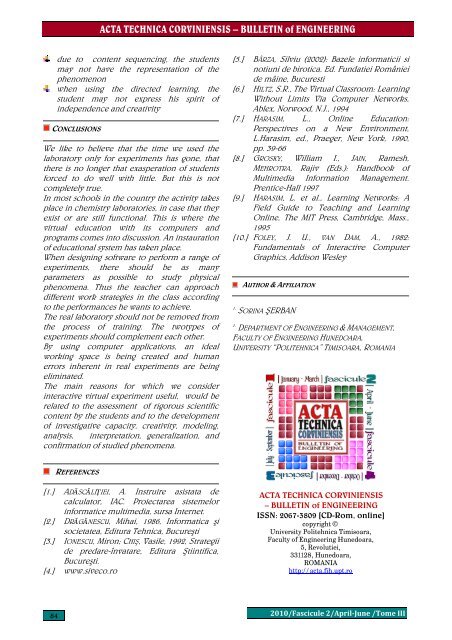ACTA TECHNICA CORVINIENSIS - Bulletin of Engineering
ACTA TECHNICA CORVINIENSIS - Bulletin of Engineering
ACTA TECHNICA CORVINIENSIS - Bulletin of Engineering
- No tags were found...
You also want an ePaper? Increase the reach of your titles
YUMPU automatically turns print PDFs into web optimized ePapers that Google loves.
<strong>ACTA</strong> <strong>TECHNICA</strong> <strong>CORVINIENSIS</strong> – BULLETIN <strong>of</strong> ENGINEERINGdue to content sequencing, the studentsmay not have the representation <strong>of</strong> thephenomenonwhen using the directed learning, thestudent may not express his spirit <strong>of</strong>independence and creativityCONCLUSIONSWe like to believe that the time we used thelaboratory only for experiments has gone, thatthere is no longer that exasperation <strong>of</strong> studentsforced to do well with little. But this is notcompletely true.In most schools in the country the activity takesplace in chemistry laboratories, in case that theyexist or are still functional. This is where thevirtual education with its computers andprograms comes into discussion. An instauration<strong>of</strong> educational system has taken place.When designing s<strong>of</strong>tware to perform a range <strong>of</strong>experiments, there should be as manyparameters as possible to study physicalphenomena. Thus the teacher can approachdifferent work strategies in the class accordingto the performances he wants to achieve.The real laboratory should not be removed fromthe process <strong>of</strong> training. The twotypes <strong>of</strong>experiments should complement each other.By using computer applications, an idealworking space is being created and humanerrors inherent in real experiments are beingeliminated.The main reasons for which we considerinteractive virtual experiment useful, would berelated to the assessment <strong>of</strong> rigorous scientificcontent by the students and to the development<strong>of</strong> investigative capacity, creativity, modeling,analysis, interpretation, generalization, andconfirmation <strong>of</strong> studied phenomena.[5.] BÂRZA, Silviu (2002): Bazele informaticii sinotiuni de birotica. Ed. Fundatiei Românieide mâine, Bucuresti[6.] HILTZ, S.R., The Virtual Classroom: LearningWithout Limits Via Computer Networks,Ablex, Norwood, N.J., 1994[7.] HARASIM, L., Online Education:Perspectives on a New Environment,L.Harasim, ed., Praeger, New York, 1990,pp. 39-66[8.] GROSKY, William I., JAIN, Ramesh,MEHROTRA, Rajiv (Eds.): Handbook <strong>of</strong>Multimedia Information Management.Prentice-Hall 1997[9.] HARASIM, L. et al., Learning Networks: AField Guide to Teaching and LearningOnline, The MIT Press, Cambridge, Mass.,1995[10.] FOLEY, J. U., VAN DAM, A., 1982:Fundamentals <strong>of</strong> Interactive ComputerGraphics, Addison WesleyAUTHOR & AFFILIATION1.SORINA ŞERBAN1.DEPARTMENT OF ENGINEERING & MANAGEMENT,FACULTY OF ENGINEERING HUNEDOARA,UNIVERSITY “POLITEHNICA” TIMISOARA, ROMANIAREFERENCES[1.] ADĂSCĂLIŢIEI, A. Instruire asistata decalculator, IAC. Proiectarea sistemelorinformatice multimedia, sursa Internet.[2.] DRĂGĂNESCU, Mihai, 1986, Informatica şisocietatea, Editura Tehnica, Bucureşti[3.] IONESCU, Miron; CHIŞ, Vasile, 1992, Strategiide predare-învatare, Editura Ştiintifica,Bucureşti.[4.] www.siveco.ro<strong>ACTA</strong> <strong>TECHNICA</strong> <strong>CORVINIENSIS</strong>– BULLETIN <strong>of</strong> ENGINEERINGISSN: 2067-3809 [CD-Rom, online]copyright ©University Politehnica Timisoara,Faculty <strong>of</strong> <strong>Engineering</strong> Hunedoara,5, Revolutiei,331128, Hunedoara,ROMANIAhttp://acta.fih.upt.ro842010/Fascicule 2/AprilJune /Tome III
















